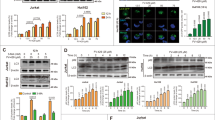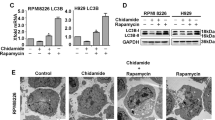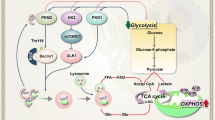Abstract
Autophagy, a tightly regulated lysosome-dependent catabolic pathway, is important in the regulation of cancer development and progression and in determining the response of tumor cells to anticancer therapy. However, the role of autophagy in leukemia still remains largely unknown. Here we show that high-mobility group box 1 (HMGB1), the best characterized damage-associated molecular pattern, was released from leukemia cell lines after chemotherapy-induced cytotoxicity and activated autophagy to protect against injury. Treatment with HMGB1-neutralizing antibodies increased the sensitivity of leukemia cells to chemotherapy; whereas, exogenous HMGB1 rendered these cells more resistant to drug-induced cytotoxicity. Moreover, exogenous HMGB1 increased autophagy as evaluated by increased expression of the autophagic marker microtubule-associated protein light chain 3-II, degradation of sequestosome 1 (p62) and autophagosome formation. Furthermore, knockdown or pharmacological inhibition of either phosphoinositide 3-kinase-III or extracellular signal-regulated kinase kinase mitogen-activated protein kinase kinase/extracellular signal-regulated protein kinase inhibited HMGB1-induced autophagy. Taken together, these results suggest that HMGB1 release after chemotherapy is a critical regulator of autophagy and a potential drug target for therapeutic interventions in leukemia.
This is a preview of subscription content, access via your institution
Access options
Subscribe to this journal
Receive 12 print issues and online access
$259.00 per year
only $21.58 per issue
Buy this article
- Purchase on Springer Link
- Instant access to full article PDF
Prices may be subject to local taxes which are calculated during checkout






Similar content being viewed by others
References
Kondo Y, Kanzawa T, Sawaya R, Kondo S . The role of autophagy in cancer development and response to therapy. Nat Rev Cancer 2005; 5: 726–734.
Mizushima N, Yoshimori T, Levine B . Methods in mammalian autophagy research. Cell 2010; 140: 313–326.
White E, DiPaola RS . The double-edged sword of autophagy modulation in cancer. Clin Cancer Res 2009; 15: 5308–5316.
Livesey KM, Tang D, Zeh HJ, Lotze MT . Autophagy inhibition in combination cancer treatment. Curr Opin Investig Drugs 2009; 10: 1269–1279.
Maclean KH, Dorsey FC, Cleveland JL, Kastan MB . Targeting lysosomal degradation induces p53-dependent cell death and prevents cancer in mouse models of lymphomagenesis. J Clin Invest 2008; 118: 79–88.
Lotze MT, Tracey KJ . High-mobility group box 1 protein (HMGB1): nuclear weapon in the immune arsenal. Nat Rev Immunol 2005; 5: 331–342.
Tang D, Shi Y, Jang L, Wang K, Xiao W, Xiao X . Heat shock response inhibits release of high mobility group box 1 protein induced by endotoxin in murine macrophages. Shock 2005; 23: 434–440.
Tang D, Kang R, Cao L, Zhang G, Yu Y, Xiao W et al. A pilot study to detect high mobility group box 1 and heat shock protein 72 in cerebrospinal fluid of pediatric patients with meningitis. Crit Care Med 2008; 36: 291–295.
Tang D, Kang R, Zeh III HJ, Lotze MT . High-mobility group box 1 and cancer. Biochim Biophys Acta 2010; 1799: 131–140.
Campana L, Bosurgi L, Rovere-Querini P . HMGB1: a two-headed signal regulating tumor progression and immunity. Curr Opin Immunol 2008; 20: 518–523.
Tang D, Kang R, Livesey KM, Cheh C, Adam Farkas A, Loughran P et al. Endogenous HMGB1 regulates autophagy. J Cell Biol 2010; 190: 881–892.
Tang D, Kang R, Cheh CW, Livesey KM, Liang X, Schapiro NE et al. HMGB1 release and redox regulates autophagy and apoptosis in cancer cells. Oncogene 2010; 29: 5299–5310.
Kang R, Tang D, Schapiro NE, Livesey KM, Farkas A, Loughran P et al. The receptor for advanced glycation end products (RAGE) sustains autophagy and limits apoptosis, promoting pancreatic tumor cell survival. Cell Death Differ 2010; 17: 666–676.
Xie M, Kang R, Yu Y, Zhu S, He YL, Xu WQ et al. Enhancive effect of HMGB1 gene silence on adriamycin-induced apoptosis in K562/A02 drug resistance leukemia cells. Zhonghua Xue Ye Xue Za Zhi 2008; 29: 549–552.
Yu Y, Xie M, He YL, Xu WQ, Zhu S, Cao LZ . Role of high mobility group box 1 in adriamycin-induced apoptosis in leukemia K562 cells. Ai Zheng 2008; 27: 929–933.
Kang R, Tang D, Yu Y, Wang Z, Hu T, Wang H et al. WAVE1 regulates Bcl-2 localization and phosphorylation in leukemia cells. Leukemia 2010; 24: 177–186.
Tang D, Kang R, Xiao W, Jiang L, Liu M, Shi Y et al. Nuclear heat shock protein 72 as a negative regulator of oxidative stress (Hydrogen Peroxide)-induced HMGB1 cytoplasmic translocation and release. J Immunol 2007; 178: 7376–7384.
Tang D, Shi Y, Kang R, Li T, Xiao W, Wang H et al. Hydrogen peroxide stimulates macrophages and monocytes to actively release HMGB1. J Leukoc Biol 2007; 81: 741–747.
Tang D, Kang R, Xiao W, Wang H, Calderwood SK, Xiao X . The Anti-inflammatory effects of heat shock protein 72 involve inhibition of high-mobility-group box 1 release and proinflammatory function in macrophages. J Immunol 2007; 179: 1236–1244.
Yla-Anttila P, Vihinen H, Jokitalo E, Eskelinen EL . Monitoring autophagy by electron microscopy in mammalian cells. Methods Enzymol 2009; 452: 143–164.
Bell CW, Jiang W, Reich III CF, Pisetsky DS . The extracellular release of HMGB1 during apoptotic cell death. Am J Physiol Cell Physiol 2006; 291: C1318–C1325.
Tang D, Kang R, Xiao W, Zhang H, Lotze MT, Wang H et al. Quercetin prevents LPS-induced high-mobility group box 1 release and proinflammatory function. Am J Respir Cell Mol Biol 2009; 41: 651–660.
Bellodi C, Lidonnici MR, Hamilton A, Helgason GV, Soliera AR, Ronchetti M et al. Targeting autophagy potentiates tyrosine kinase inhibitor-induced cell death in Philadelphia chromosome-positive cells, including primary CML stem cells. J Clin Invest 2009; 119: 1109–1123.
Carew JS, Nawrocki ST, Kahue CN, Zhang H, Yang C, Chung L et al. Targeting autophagy augments the anticancer activity of the histone deacetylase inhibitor SAHA to overcome Bcr-Abl-mediated drug resistance. Blood 2007; 110: 313–322.
Pankiv S, Clausen TH, Lamark T, Brech A, Bruun JA, Outzen H et al. p62/SQSTM1 binds directly to Atg8/LC3 to facilitate degradation of ubiquitinated protein aggregates by autophagy. J Biol Chem 2007; 282: 24131–24145.
Pattingre S, Tassa A, Qu X, Garuti R, Liang XH, Mizushima N et al. Bcl-2 antiapoptotic proteins inhibit Beclin 1-dependent autophagy. Cell 2005; 122: 927–939.
Petiot A, Ogier-Denis E, Blommaart EF, Meijer AJ, Codogno P . Distinct classes of phosphatidylinositol 3′-kinases are involved in signaling pathways that control macroautophagy in HT-29 cells. J Biol Chem 2000; 275: 992–998.
Lee Jr JT, McCubrey JA . The Raf/MEK/ERK signal transduction cascade as a target for chemotherapeutic intervention in leukemia. Leukemia 2002; 16: 486–507.
Ross DD . Novel mechanisms of drug resistance in leukemia. Leukemia 2000; 14: 467–473.
Taguchi A, Blood DC, del Toro G, Canet A, Lee DC, Qu W et al. Blockade of RAGE-amphoterin signalling suppresses tumour growth and metastases. Nature 2000; 405: 354–360.
Apetoh L, Ghiringhelli F, Tesniere A, Criollo A, Ortiz C, Lidereau R et al. The interaction between HMGB1 and TLR4 dictates the outcome of anticancer chemotherapy and radiotherapy. Immunol Rev 2007; 220: 47–59.
Kang R, Tang DL, Cao LZ, Yu Y, Zhang GY, Xiao XZ . High mobility group box 1 is increased in children with acute lymphocytic leukemia and stimulates the release of tumor necrosis factor-alpha in leukemic cell. Zhonghua Er Ke Za Zhi 2007; 45: 329–333.
Chung HW, Lee SG, Kim H, Hong DJ, Chung JB, Stroncek D et al. Serum high mobility group box-1 (HMGB1) is closely associated with the clinical and pathologic features of gastric cancer. J Transl Med 2009; 7: 38.
Maeda S, Hikiba Y, Shibata W, Ohmae T, Yanai A, Ogura K et al. Essential roles of high-mobility group box 1 in the development of murine colitis and colitis-associated cancer. Biochem Biophys Res Commun 2007; 360: 394–400.
Liang X, Chavez AR, Schapiro NE, Loughran P, Thorne SH, Amoscato AA et al. Ethyl pyruvate administration inhibits hepatic tumor growth. J Leukoc Biol 2009; 86: 599–607.
Apel A, Herr I, Schwarz H, Rodemann HP, Mayer A . Blocked autophagy sensitizes resistant carcinoma cells to radiation therapy. Cancer Res 2008; 68: 1485–1494.
Wang J, Lian H, Zhao Y, Kauss MA, Spindel S . Vitamin D3 induces autophagy of human myeloid leukemia cells. J Biol Chem 2008; 283: 25596–25605.
Wullschleger S, Loewith R, Hall MN . TOR signaling in growth and metabolism. Cell 2006; 124: 471–484.
Kihara A, Kabeya Y, Ohsumi Y, Yoshimori T . Beclin-phosphatidylinositol 3-kinase complex functions at the trans-Golgi network. EMBO Rep 2001; 2: 330–335.
Zhuang ZY, Xu H, Clapham DE, Ji RR . Phosphatidylinositol 3-kinase activates ERK in primary sensory neurons and mediates inflammatory heat hyperalgesia through TRPV1 sensitization. J Neurosci 2004; 24: 8300–8309.
Davies CC, Mason J, Wakelam MJ, Young LS, Eliopoulos AG . Inhibition of phosphatidylinositol 3-kinase- and ERK MAPK-regulated protein synthesis reveals the pro-apoptotic properties of CD40 ligation in carcinoma cells. J Biol Chem 2004; 279: 1010–1019.
Ozaki K, Kosugi M, Baba N, Fujio K, Sakamoto T, Kimura S et al. Blockade of the ERK or PI3K-Akt signaling pathway enhances the cytotoxicity of histone deacetylase inhibitors in tumor cells resistant to gefitinib or imatinib. Biochem Biophys Res Commun 2010; 391: 1610–1615.
Ramos AM, Fernandez C, Amran D, Sancho P, de Blas E, Aller P . Pharmacologic inhibitors of PI3K/Akt potentiate the apoptotic action of the antileukemic drug arsenic trioxide via glutathione depletion and increased peroxide accumulation in myeloid leukemia cells. Blood 2005; 105: 4013–4020.
Milella M, Kornblau SM, Estrov Z, Carter BZ, Lapillonne H, Harris D et al. Therapeutic targeting of the MEK/MAPK signal transduction module in acute myeloid leukemia. J Clin Invest 2001; 108: 851–859.
Bassi R, Giussani P, Anelli V, Colleoni T, Pedrazzi M, Patrone M et al. HMGB1 as an autocrine stimulus in human T98G glioblastoma cells: role in cell growth and migration. J Neurooncol 2008; 87: 23–33.
Sivaprasad U, Basu A . Inhibition of ERK attenuates autophagy and potentiates tumour necrosis factor-alpha-induced cell death in MCF-7 cells. J Cell Mol Med 2008; 12: 1265–1271.
Wang J, Whiteman MW, Lian H, Wang G, Singh A, Huang D et al. A non-canonical MEK/ERK signaling pathway regulates autophagy via regulating Beclin 1. J Biol Chem 2009; 284: 21412–21424.
Acknowledgements
This work was supported by grants from The National Natural Sciences Foundation of China (30571982, 30772353, 30973234 to LC, 30500485 to DT), Doctoral Program of Higher Education of China (20070533042 to LC), and a grant from University of Pittsburgh (DT).
Author information
Authors and Affiliations
Corresponding authors
Ethics declarations
Competing interests
The authors declare no conflict of interest.
Rights and permissions
About this article
Cite this article
Liu, L., Yang, M., Kang, R. et al. HMGB1-induced autophagy promotes chemotherapy resistance in leukemia cells. Leukemia 25, 23–31 (2011). https://doi.org/10.1038/leu.2010.225
Received:
Revised:
Accepted:
Published:
Issue Date:
DOI: https://doi.org/10.1038/leu.2010.225
Keywords
This article is cited by
-
Laminar shear stress inhibits inflammation by activating autophagy in human aortic endothelial cells through HMGB1 nuclear translocation
Communications Biology (2022)
-
Crosstalk between autophagy and microbiota in cancer progression
Molecular Cancer (2021)
-
COX2 confers bone marrow stromal cells to promoting TNFα/TNFR1β-mediated myeloma cell growth and adhesion
Cellular Oncology (2021)
-
Chronic stress promotes acute myeloid leukemia progression through HMGB1/NLRP3/IL-1β signaling pathway
Journal of Molecular Medicine (2021)
-
HMGB1: an important regulator of myeloid differentiation and acute myeloid leukemia as well as a promising therapeutic target
Journal of Molecular Medicine (2021)



